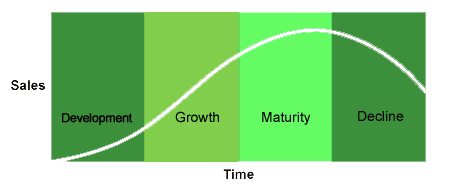

|
Product Items, Lines, and Brands |
Copyright 2006
Cornell
University.
All rights reserved.
| Introduction and Objectives
Even before you build your first prototype, you should be thinking about the life cycle of your product and business. Planning for the decline of a product in the marketplace is just as important as its introduction and growth. A product's life cycle stages and sales curves typically follow the path shown below.
Product Life Cycle Stages The business life cycle curve looks similar. It has a development stage where little profit is made. Then the growth and maturity stages where both sales and profit increase. Finally, the business may decline. Some businesses progress through these stages rapidly and others do so slowly, depending on the type of company and the entrepreneur's goals. For example, the business may be
Each affects the length and shape of this curve differently.
This module will explore product as well as business life cycles. It will ask specific questions that you should be able to answer as you develop new products, product lines, and a distinctive brand. You will compare several potential markets in which you can position your product. You will also develop your expectations for the life cycle you want your business to follow. You will consider whether to grow the business through your lifetime and pass it on to your heirs or plan a fast growth and early exit strategy. You will realize that thinking about the maturity and decline of a business venture is as important as developing its first product. Objectives:
|

